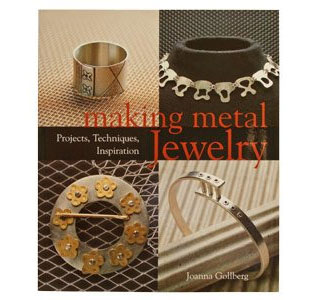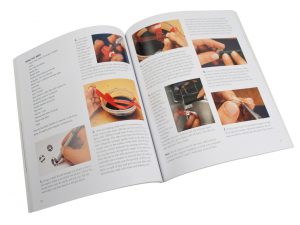First and foremost, this is a book about cold fixing techniques or ‘cold connections’. Its focus is on what can be achieved without the use of heat and is therefore instantly suitable for beginners and hobbyists. Written in a ‘classroom style’ format, the text is concise but comprehensive and includes some valuable tips which are often overlooked.
The introduction covers the basics; materials, tools, techniques, findings and finishing and is a surprisingly small section. I like quite like the fact that it is so small, as I think it makes the projects far less daunting. You can get conditioned into thinking that jewellery is such a vast subject that it becomes a bit overwhelming. Not something you have to worry about with this book.
The techniques section basically covers sawing, riveting and chasing and that’s it! Quite a change from other texts and really goes to show just what is possible with a little knowledge. Gollberg makes the point that practise really is the key to success. She suggests doing the same thing over and over again until perfect which is more of a Scandinavian approach to jewellery teaching and ensures a more professional finish. I particularly like her tips on sawing. She writes as though she is standing in front of you teaching which is great. Gollbergs depiction of riveting is also very well written with steps which are easy to follow and great tips and troubleshooting advice to avoid mistakes.
The remainder of the text (approx.70 pages) is divided into a series of projects which illustrate the diversity of cold fixing. There are 21 projects in total covering everything from bangles to rings and even a pair of stud earrings! They vary in their complexity but there are explanatory photos throughout which help to make things clearer. Anyone with basic/intermediate jewellery knowledge should be able to tackle these projects successfully and I like the fact that some steps are left deliberately vague allowing for your own design input just as you would in a classroom environment. I have read some reviews that criticise this but I don’t agree. Gollberg is simply providing the foundation blocks for your own creativity which is to be encouraged.
What I found interesting about this book is how your approach to designing a piece of jewellery changes as you work your way through the projects. By taking soldering out of the equation, you are forced to think differently, more innovatively about how things will be joined together. Instead of merely being functional, your joining mechanism can become decorative, more integral to the overall design which can bring about some fascinating results. It also opens up a whole new range of material options which is illustrated quite clearly by the gallery of images at the back of the book.
In conclusion I would say that ‘Making Metal Jewellery’ would be a great addition to the bookshelf of any designer working with metal. Suitable not only for beginners, but for anyone looking for a fresh approach to their work. A surprisingly inspirational read!

Cooksongold


